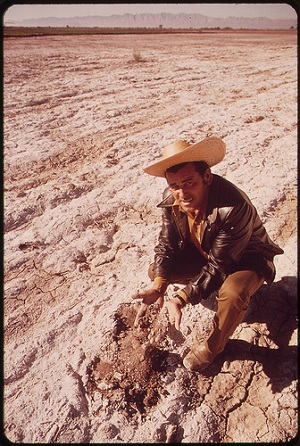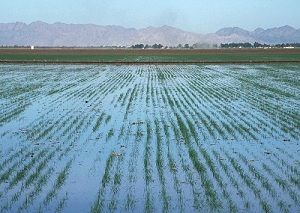Salinization
People need food and desert (arid and semi-arid) soils are generally very fertile, as there is very little water to wash out the nutrients. Therefore, in order for most food crops to grow (wheat, corn, barley, etc.), irrigation is needed. Irrigation has the capacity to increase crop yields over 10 times compared to fields without irrigation. But, without proper management, the soils can become a salty mess, incapable of crop production. About 20% of the total amount of irrigated land on the planet has already been damaged by salinization.
There is also a type of salinity known as dryland salinity, which does not occur on irrigated lands. Salts come from deep underground as the water table rises.

Poor soil that is damaged by accumulated salt content from poor quality irrigation water near Mexicali, Mexico. May 1972. Credit: Charles O'Rear. US Archives 412-DA-6597

Basin flood irrigation on wheat. Yuma, Az. Credit: Jeff Vanuga, USDA-NRCS
High salt concentrations are not good for growing plants. Salts do not allow plants to grow or absorb moisture; they also remove moisture already in the plant. Salt also destroys the soil structure, so water cannot easily flow through it, which can cause plants to die from being waterlogged. Each year more than 1.5 million hectares (3.7 million acres) of once-arable land becomes unproductive from salinization, leading to an $11 billion loss in the world food market. Many areas of the world suffer from rising salinity today.

Salt-affected soils are visible on rangeland in Colorado. Salts dissolved from the soil accumulate at the soil surface and are deposited on the ground and at the base of the fence post. Credit: USDA NRCS
Fixing Salinity
A project in Jordan works to suppress evaporation while harvesting incoming water. This can be done in several ways - placing mulch over the soil surface which increases the moisture in the soil and decreases the exposure of soil to the sun and lowers the accumulation of salts. The construction of sunken beds, which involved digging a pit so water flows down to where the plants are growing, helps to harvest incoming water (and rainwater has fewer dissolved salts).

Drip irrigation can reduce evaporation.
Drip irrigation is a micro-irrigation system that can reduce evaporation by only watering in the root zone of plants rather than across an entire area with traditional watering systems. It can save water and keep nutrients from leaching and salt from accumulating.
Read more about the Challenge of Salinization - an historical case, modern case, and looking ahead.
Go back to the Human/ Soil Interaction Page
Go back to the Desert Biome Page



